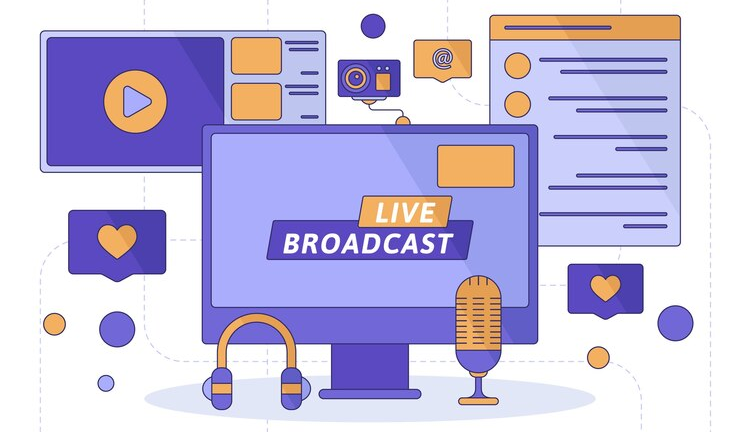Motion graphics have revolutionized the way information is presented and communicated in broadcast media. In the realm of television, online streaming, and even corporate presentations, motion graphics play a crucial role in enhancing visual storytelling and engaging audiences. This blog explores the intricacies of motion graphics, particularly within broadcast graphics packages, highlighting their significance, components, creative process, and the role of motion graphics services in delivering compelling visual content.
Introduction to Motion Graphics
Motion graphics refer to animated graphic design elements that bring static graphics to life through movement. They combine visual aesthetics, animation principles, and storytelling techniques to convey information dynamically. In broadcast media, motion graphics serve various purposes, including introducing programs, illustrating data, enhancing transitions, and reinforcing branding.
Importance of Motion Graphics in Broadcast Graphics Packages
Broadcast graphics packages are comprehensive sets of graphical elements used consistently across a broadcast network or program. These packages include lower thirds, bumpers, transitions, logos, and other visual elements that maintain brand consistency and enhance viewer engagement. Motion graphics within these packages elevate the production value and help establish a visual identity for the broadcaster or program.
Motion graphics serve several critical functions within broadcast graphics packages:
-
Brand Recognition: They incorporate logos, color schemes, and typography that align with the broadcaster’s brand identity, reinforcing brand recognition among viewers.
-
Information Delivery: Motion graphics effectively communicate information such as news headlines, weather updates, sports scores, and financial data in a visually engaging manner.
-
Audience Engagement: Dynamic animations and transitions keep viewers engaged during program segments, commercials, and transitions between different content.
-
Professionalism and Aesthetics: High-quality motion graphics lend a professional and polished look to broadcast content, enhancing the overall viewer experience.
Components of Motion Graphics
Motion graphics are composed of several key components that contribute to their effectiveness:
-
Design Elements: This includes typography, icons, shapes, and images that are animated to convey specific messages or enhance visual appeal.
-
Animation Techniques: Techniques such as keyframing, easing, and timing play a crucial role in how elements move and behave on-screen, ensuring smooth transitions and engaging movements.
-
Sound Design: Audio elements such as sound effects and background music complement motion graphics, enriching the viewer’s sensory experience.
-
Software Tools: Motion graphics are created using specialized software like Adobe After Effects, Cinema 4D, and Autodesk Maya, which offer robust capabilities for animation and visual effects.
Creative Process in Motion Graphics Production
The creation of motion graphics for broadcast graphics packages follows a structured creative process:
-
Concept Development: Understanding the client’s brief, target audience, and branding guidelines to conceptualize designs that align with the broadcaster’s identity and objectives.
-
Storyboarding: Creating a visual storyboard to outline the sequence of animations, transitions, and graphical elements that will be used in the motion graphics package.
-
Design and Animation: Developing graphical assets and animating them using motion graphics software, paying attention to timing, movement, and visual coherence.
-
Feedback and Iteration: Incorporating client feedback and making necessary revisions to ensure the final product meets expectations and aligns with branding guidelines.
-
Delivery: Exporting motion graphics files in the appropriate formats and resolutions for seamless integration into broadcast systems or digital platforms.
Role of Motion Graphics Services
Motion graphics services specialize in the creation, customization, and integration of motion graphics into broadcast graphics packages. These services offer several benefits to broadcasters and content creators:
-
Expertise and Experience: Motion graphics services employ skilled designers and animators with expertise in creating visually appealing and effective motion graphics.
-
Customization: They tailor motion graphics to align with the broadcaster’s brand identity, content requirements, and audience preferences, ensuring a cohesive visual experience.
-
Efficiency: Outsourcing motion graphics to specialized services allows broadcasters to focus on content creation and programming while ensuring high-quality graphics production.
-
Technological Advancements: Motion graphics services stay updated with the latest software tools and animation techniques, leveraging technological advancements to deliver cutting-edge visuals.
-
Scalability: Whether for a single program or an entire network, motion graphics services can scale their production capabilities to meet varying project demands and deadlines.
Conclusion
Motion graphics are indispensable in modern broadcast media, enhancing visual storytelling, brand recognition, and audience engagement through dynamic animation and design. Broadcast graphics packages benefit significantly from well-crafted motion graphics, which not only convey information effectively but also contribute to the overall professionalism and appeal of television programming. Motion graphics services play a pivotal role in this ecosystem, providing specialized expertise and resources to deliver compelling visual content that captivates viewers and reinforces brand identity.
In essence, motion graphics services are not just about animation; they are integral partners in shaping how broadcasters connect with audiences through captivating and informative visual experiences.

